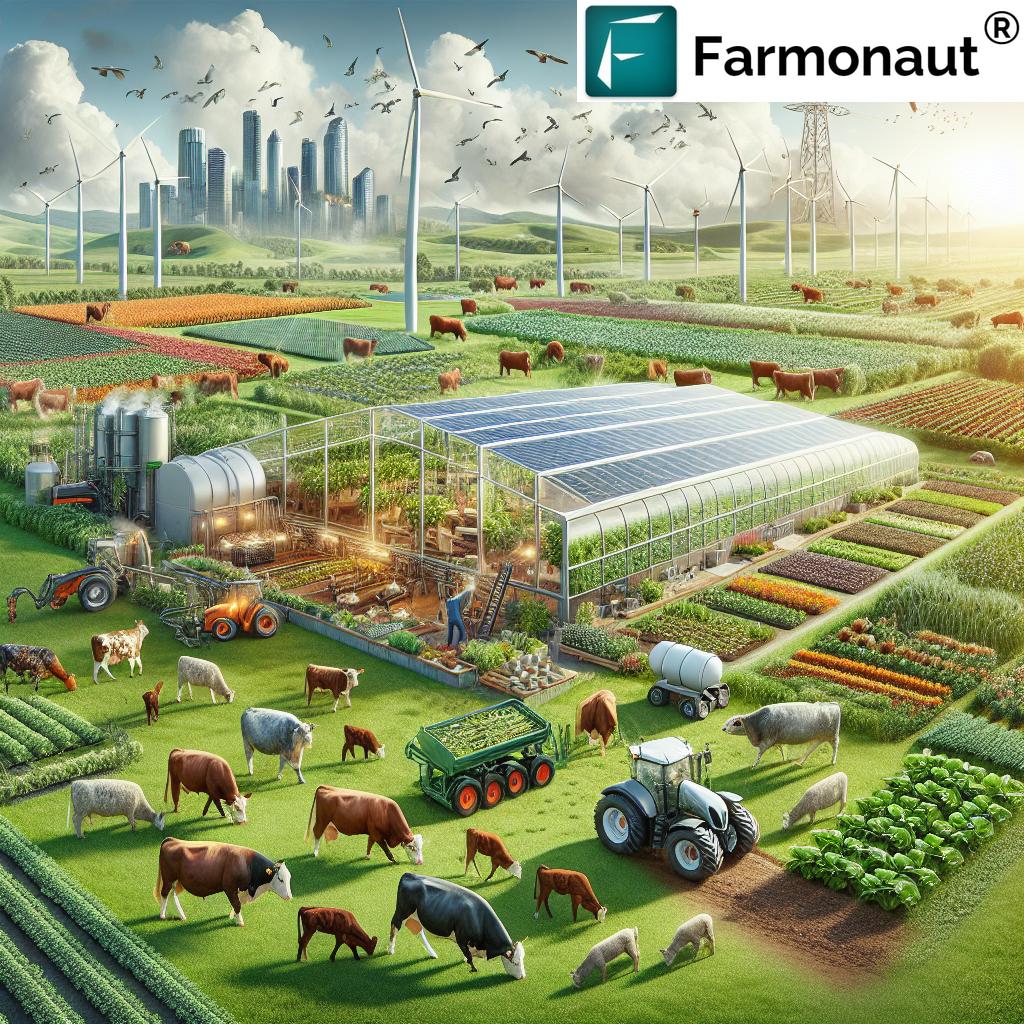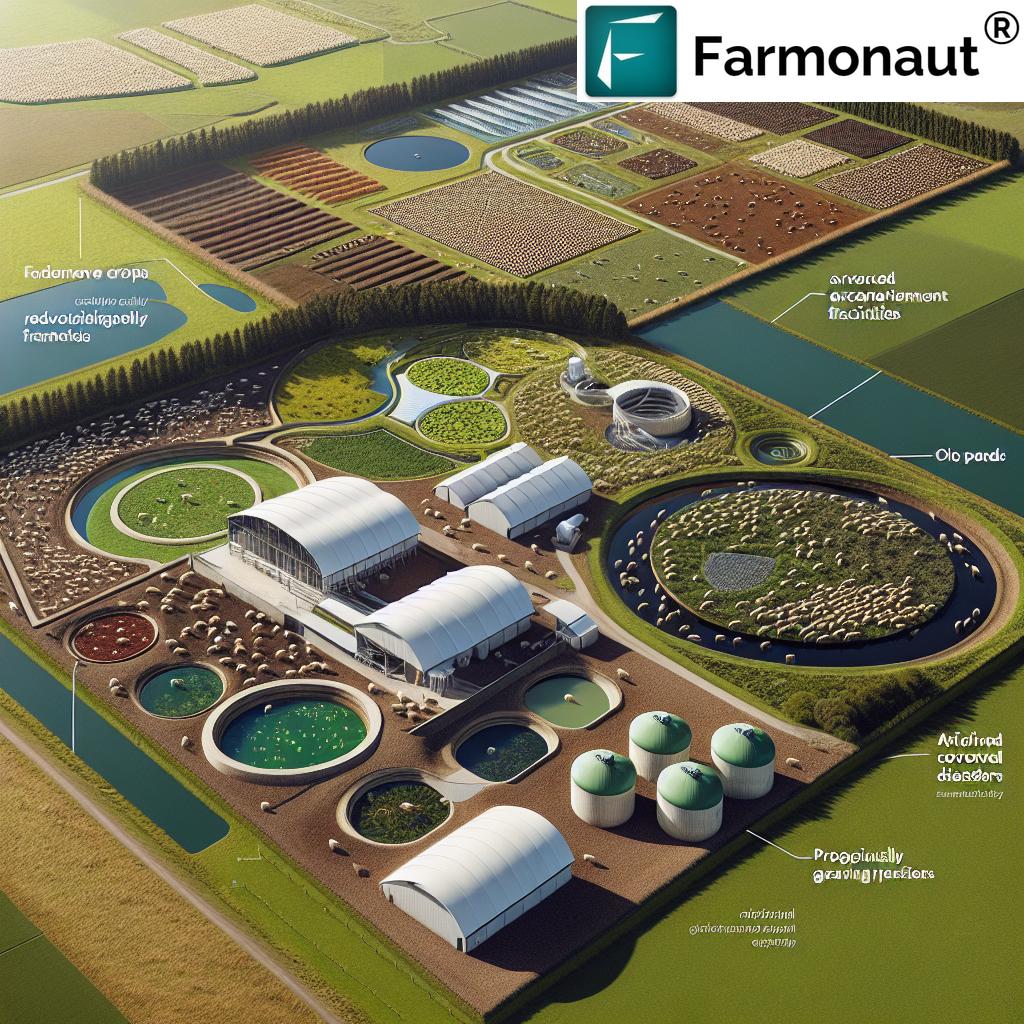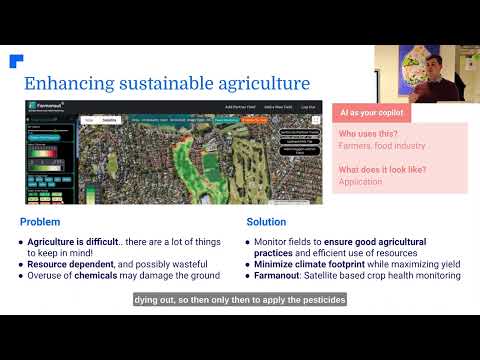Sustainable Farming Revolution: A Comprehensive Guide to Achieving Net-Zero Emissions on Your Farm in Australia and New Zealand

“Livestock contribute up to 14.5% of global greenhouse gas emissions, making sustainable farming practices crucial for climate change mitigation.”
Welcome to our comprehensive guide on achieving net-zero emissions on your farm in Australia and New Zealand. As we navigate the challenges of climate change, sustainable farming practices have become more critical than ever. In this blog post, we’ll explore innovative strategies and technologies that can help farmers reduce their carbon footprint while optimizing productivity and profitability.
At Farmonaut, we’re committed to making precision agriculture accessible and affordable for farmers worldwide. Our satellite-based farm management solutions provide valuable insights that can help you transition towards a more sustainable and efficient farming model. Let’s dive into the world of net-zero agriculture and discover how you can revolutionize your farming practices.
Understanding Net-Zero Agriculture
Net-zero agriculture refers to a farming system that balances the greenhouse gases emitted with an equivalent amount removed from the atmosphere. This concept is crucial for mitigating climate change and ensuring long-term sustainability in the agricultural sector. Achieving net-zero emissions on your farm involves a combination of reducing emissions and enhancing carbon sequestration.
- Reducing emissions from livestock, machinery, and fertilizer use
- Improving soil health to increase carbon storage
- Adopting renewable energy sources
- Implementing efficient resource management techniques
By embracing these practices, farmers in Australia and New Zealand can play a significant role in combating climate change while also improving their farm’s resilience and productivity.
Livestock Emissions Reduction: A Key Focus Area
Livestock emissions, particularly from cattle and sheep, are a significant contributor to greenhouse gases in Australia and New Zealand. To achieve net-zero emissions, it’s crucial to address this area through various strategies:
- Genetic improvement in livestock: Breeding animals for better feed efficiency and reduced methane production
- Feed efficiency strategies: Optimizing diets to reduce enteric fermentation and improve nutrient utilization
- Manure management techniques: Implementing anaerobic digesters and composting systems to reduce methane emissions from manure
These approaches not only reduce emissions but also contribute to improved animal welfare and productivity, creating a win-win situation for farmers and the environment.
Soil Health and Carbon Sequestration
Healthy soils are not only crucial for crop productivity but also play a vital role in carbon sequestration. By implementing sustainable soil management practices, farmers can significantly contribute to achieving net-zero emissions:
- Minimum tillage or no-till farming: Reduces soil disturbance and helps retain organic matter
- Cover cropping: Improves soil structure, prevents erosion, and increases carbon storage
- Crop rotation: Enhances soil fertility and reduces the need for synthetic fertilizers
- Biochar application: Increases soil carbon content and improves water retention
Farmonaut’s satellite-based crop health monitoring can help you track the impact of these practices on your soil health and overall farm productivity.
Precision Agriculture: Optimizing Resource Use
Precision agriculture techniques are instrumental in reducing greenhouse gas emissions by optimizing resource use. By leveraging technologies like satellite imagery and AI-driven insights, farmers can make data-driven decisions that lead to more efficient farming practices:
- Variable rate application: Applying inputs like fertilizers and pesticides precisely where needed
- Irrigation management: Using soil moisture sensors and weather data to optimize water use
- Crop health monitoring: Early detection of pest and disease issues to reduce crop losses and chemical use
Farmonaut’s Jeevn AI Advisory System provides real-time insights and personalized recommendations to help you implement these precision agriculture techniques effectively.
Renewable Energy Integration
Transitioning to renewable energy sources is a crucial step towards achieving net-zero emissions on your farm. Australia and New Zealand have abundant renewable resources that can be harnessed:
- Solar panels: Ideal for powering farm buildings, irrigation systems, and electric vehicles
- Wind turbines: Suitable for larger farms with consistent wind patterns
- Biogas digesters: Convert organic waste into energy, particularly useful for livestock farms
By integrating these renewable energy solutions, you can significantly reduce your farm’s carbon footprint while also lowering energy costs in the long run.
“Implementing net-zero farming strategies can potentially increase farm profitability by 10-20% through improved efficiency and resource management.”
Agroforestry and Carbon Offsetting
Incorporating trees and shrubs into your farming system through agroforestry can provide multiple benefits:
- Increased carbon sequestration
- Improved soil health and biodiversity
- Additional income streams through timber or fruit production
- Enhanced animal welfare through natural shade and shelter
Moreover, participating in carbon offset programs can help you achieve net-zero status by balancing any remaining emissions from your farm operations.
Explore Farmonaut’s Satellite and Weather API
Technology and Data-Driven Decision Making
Leveraging technology and data is crucial for implementing and monitoring sustainable farming practices effectively. Farmonaut’s suite of tools can help you in this journey:
- Satellite-based crop health monitoring: Track vegetation health (NDVI) and soil moisture levels
- AI-driven advisory system: Receive personalized recommendations for crop management
- Carbon footprint tracking: Monitor and reduce your farm’s environmental impact
- Blockchain-based traceability: Enhance transparency and trust in your supply chain
By integrating these technologies into your farming operations, you can make more informed decisions that contribute to both sustainability and profitability.
Comparison of Sustainable Farming Practices for Net-Zero Emissions
| Sustainable Practice | Estimated Emission Reduction (%) | Implementation Difficulty | Cost-Effectiveness | Additional Benefits |
|---|---|---|---|---|
| Manure Management Techniques | 15-30% | Medium | High | Reduced odor, improved soil health |
| Genetic Improvement in Livestock | 10-20% | High | Medium | Increased productivity, better feed efficiency |
| Feed Efficiency Strategies | 10-15% | Medium | High | Improved animal health, reduced feed costs |
| Livestock Emissions Reduction Methods | 20-30% | Medium | Medium | Enhanced animal welfare, increased productivity |
| Animal Welfare Enhancement Practices | 5-10% | Low | High | Improved product quality, consumer trust |
Government Support and Incentives
Both Australia and New Zealand offer various support programs and incentives for farmers transitioning to sustainable practices:
- Grants for implementing renewable energy solutions
- Research and development funding for sustainable farming technologies
- Tax incentives for carbon sequestration activities
- Educational programs and resources for farmers
Stay informed about these opportunities and leverage them to support your journey towards net-zero emissions.
Access Farmonaut’s API Developer Docs
Measuring and Reporting Progress
To achieve and maintain net-zero status, it’s essential to consistently measure and report your farm’s emissions and carbon sequestration activities. Farmonaut’s carbon footprinting feature can help you track your progress over time, allowing you to:
- Identify areas for improvement
- Set realistic emission reduction targets
- Demonstrate your commitment to sustainability to consumers and stakeholders
- Participate in carbon credit schemes
Regular monitoring and reporting not only help you stay on track but also contribute to the broader goal of reducing agricultural emissions in Australia and New Zealand.
Challenges and Solutions in Achieving Net-Zero Emissions
While the path to net-zero emissions is clear, it’s not without challenges. Here are some common obstacles farmers face and potential solutions:
- High initial costs: Utilize government grants and explore phased implementation of sustainable practices
- Knowledge gap: Participate in training programs and leverage Farmonaut’s AI advisory system
- Market uncertainties: Diversify income streams and explore premium markets for sustainably produced goods
- Resistance to change: Start with small, measurable improvements and build on successes
By addressing these challenges proactively, farmers can overcome barriers to implementing sustainable practices and move towards net-zero emissions.
The Future of Sustainable Farming in Australia and New Zealand
As we look to the future, the agricultural sectors in Australia and New Zealand are well-positioned to lead the way in sustainable farming practices. With a combination of innovative technologies, supportive policies, and farmer ingenuity, achieving net-zero emissions is not just a possibility but a tangible goal.
Key trends shaping the future of sustainable farming include:
- Increased adoption of precision agriculture technologies
- Growing consumer demand for sustainably produced food
- Advancements in carbon sequestration techniques
- Development of climate-resilient crop varieties
- Integration of artificial intelligence and machine learning in farm management
By staying ahead of these trends and continuously adapting, farmers can ensure their operations remain both environmentally sustainable and economically viable.
Conclusion: Your Role in the Sustainable Farming Revolution
As we conclude this comprehensive guide, it’s clear that achieving net-zero emissions on your farm is not just an environmental imperative but also a pathway to increased efficiency, resilience, and profitability. By implementing the strategies discussed – from livestock emissions reduction to precision agriculture and renewable energy integration – you can play a crucial role in mitigating climate change while optimizing your farming operations.
Remember, the journey to net-zero emissions is ongoing, and every step counts. With tools like Farmonaut’s satellite-based farm management solutions, you have the support you need to make informed decisions and track your progress. Together, we can revolutionize farming practices in Australia and New Zealand, creating a more sustainable and prosperous future for agriculture.
Start your journey towards net-zero emissions today. Explore Farmonaut’s solutions and see how we can support your sustainable farming goals.

Frequently Asked Questions (FAQ)
1. What is net-zero agriculture?
Net-zero agriculture refers to farming practices that balance the greenhouse gases emitted with an equivalent amount removed from the atmosphere, resulting in no net increase in atmospheric carbon dioxide.
2. How can livestock farmers reduce their emissions?
Livestock farmers can reduce emissions through improved manure management, genetic selection for more efficient animals, optimized feed strategies, and the use of methane-reducing feed additives.
3. What role does soil health play in achieving net-zero emissions?
Healthy soils can sequester significant amounts of carbon. Practices like no-till farming, cover cropping, and improved crop rotations enhance soil health and increase carbon storage.
4. How can Farmonaut’s technology help in achieving net-zero emissions?
Farmonaut’s satellite-based crop monitoring, AI advisory system, and carbon footprinting tools help farmers optimize resource use, improve efficiency, and track their progress towards net-zero emissions.
5. Are there financial benefits to implementing sustainable farming practices?
Yes, sustainable farming practices can lead to increased profitability through improved efficiency, reduced input costs, and access to premium markets for sustainably produced goods.
6. How long does it typically take to achieve net-zero emissions on a farm?
The timeline varies depending on the farm’s current practices and the strategies implemented. However, significant progress can often be seen within 3-5 years of implementing comprehensive sustainable practices.
7. What government support is available for farmers transitioning to net-zero practices in Australia and New Zealand?
Both countries offer various grants, tax incentives, and research funding to support farmers in adopting sustainable practices. Check with local agricultural departments for specific programs.
8. How can I measure my farm’s carbon footprint?
Farmonaut’s carbon footprinting feature can help you track your farm’s emissions. Additionally, there are various carbon calculators specifically designed for agricultural operations.
9. What are some quick wins for reducing emissions on my farm?
Quick wins can include optimizing fertilizer use, improving energy efficiency in farm buildings, and implementing rotational grazing for livestock.
10. How does achieving net-zero emissions benefit my farm’s resilience?
Net-zero practices often improve soil health, water retention, and biodiversity, making your farm more resilient to climate change impacts like droughts and extreme weather events.






